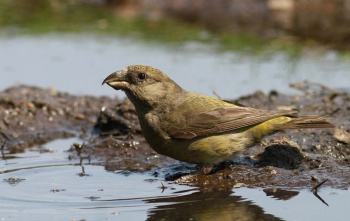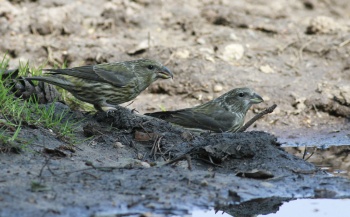- Loxia curvirostra
Alternate name: Common Crossbill
Identification
Length 14-20 cm, weight 23-53 g
Male
- Medium-sized finch
- Red-orange body
- Brighter red on rump
- Dark brown wings
- Dark bill with crossed tip
- Notched tail
Female
- Yellow-orange crown and rump
- Olive-green body
- Grey-brown wings and tail
Juvenile
Streaked greyer-brown overall
Distribution
Throughout most of the Northern Hemisphere, almost wherever substantial conifer forests occur.
In the Old World, more-or-less continuous from Scotland east to the Pacific coast of Russia, with more isolated populations south to northwest Africa, the Mediterranean islands, Turkey, the Himalaya, southern Vietnam, and Taiwan.
In North America, from southern Alaska, Manitoba, Quebec, and Newfoundland, south in the west to northern Nicaragua, and in eastern United States to Wisconsin and North Carolina (in mountains). This bird winters irregularly south to the Gulf coast.
Taxonomy
Twenty-one subspecies are recognised[1]:
- L. c. curvirostra
- L. c. corsicana
- L. c. balearica
- L. c. poliogyna
- L. c. guillemardi
- L. c. mariae
- L. c. altaiensis
- L. c. tianschanica
- L. c. himalayensis
- L. c. meridionalis
- L. c. japonica
- L. c. luzoniensis
- L. c. bendirei
- L. c. sitkensis
- L. c. benti
- L. c. minor
- L. c. grinnelli
- L. c. stricklandi
- L. c. mesamericana
- L. c. pusilla
- L. c. sinesciuris
Habitat
Coniferous forests, with a preference for spruce Picea in most areas, but pine Pinus in the case of some subspecies.
Behaviour
Diet
They eat insects and the buds and seeds of many shrubs and trees but mainly conifers with not too large cones.
Vocalisation
<flashmp3>Loxia curvirostra (song).mp3</flashmp3>
Listen in an external program
References
- Clements, JF. 2011. The Clements Checklist of Birds of the World. 6th ed., with updates to August 2011. Ithaca: Cornell Univ. Press. ISBN 978-0801445019. Spreadsheet available at http://www.birds.cornell.edu/clementschecklist/downloadable-clements-checklist
Recommended Citation
- BirdForum Opus contributors. (2024) Red Crossbill. In: BirdForum, the forum for wild birds and birding. Retrieved 21 May 2024 from https://www.birdforum.net/opus/Red_Crossbill






